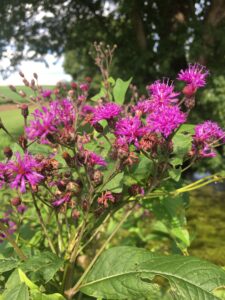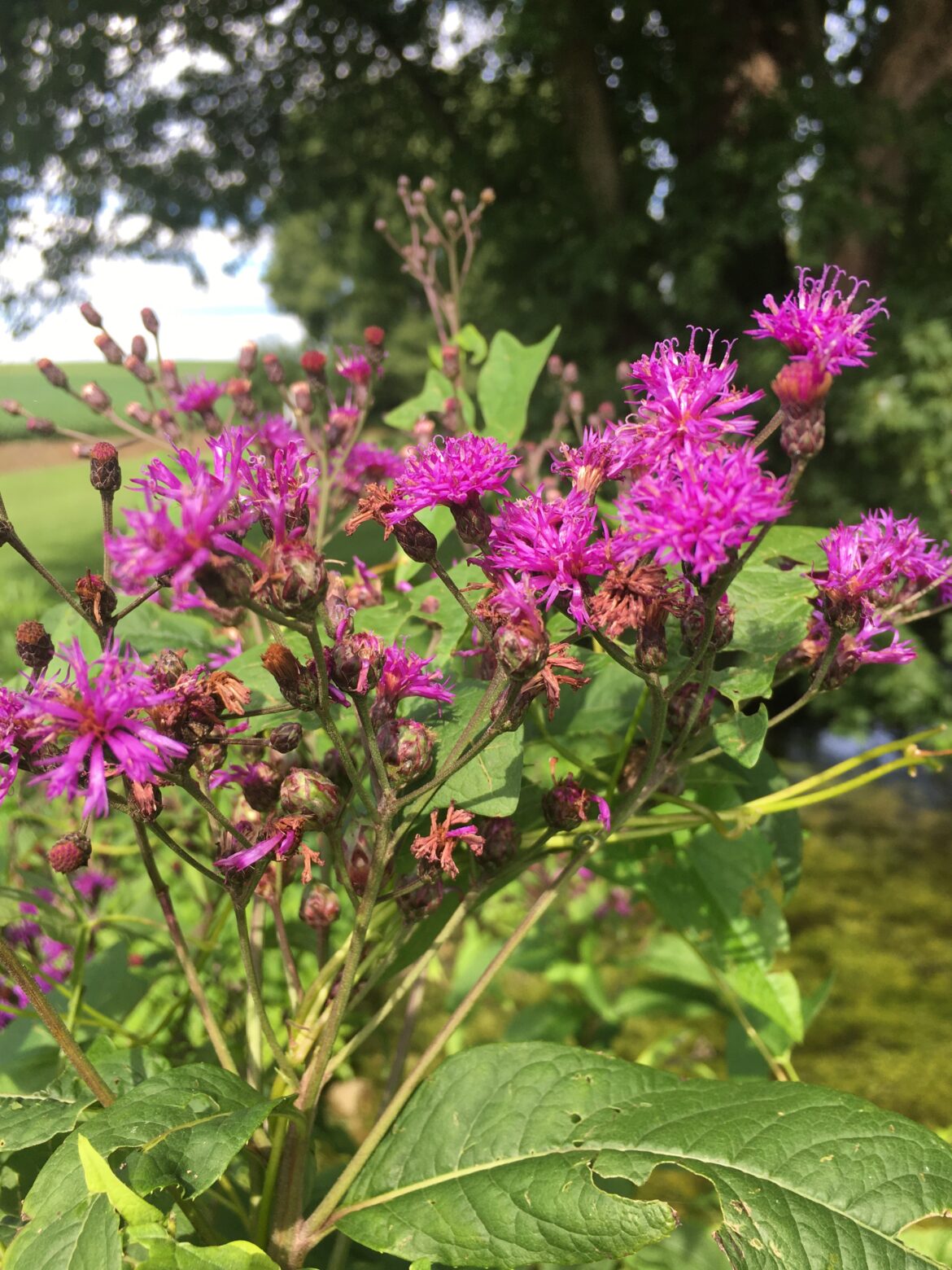 August 5th
August 5th
The 217th Day of the Year
It is the August also of my life,
And I, too, stand for a moment on a height,
Like an elm tree musing, a dark arrested fountain,
Over a far prospect, where a river swings in silent, silver arcs,
And those two restless hounds, mind and heart,
Lie quiet at my feet.
Clara Shanafelt
Sunrise/set: 5:37/7:45
Day’s Length: 14 hours 8 minutes
Average High/Low: 85/64
Average Temperature: 74
Record High: 103 – 1918
Record Low: 45 – 1972
Weather
Today’s highs are shared equally between the 80s and 90s, thirty-five percent chances of each, with a 30 percent possibility for an afternoon in the 70s. Rain falls four years out of ten. Totally cloudy skies are likely one year in four. Cool nights in the 50s occur about 30 percent of the time. The sharp contrast with yesterday’s averages shows the effect of the August 4th high-pressure system.
Natural Calendar
Butterflies often become more common this week of the year, monarchs appearing more frequently, and another generation of cabbage butterflies, swallowtails and skippers seeking nectar. Sometimes giant imperial moths come out to seek the lights of the city. Tiny alypias, shiny black moths with white spots on their wings, may find their way indoors.
Daybook
1982: Queen Anne’s lace and chicory still dominate the roadsides, with tall thistles, horseweed, wild lettuce, milkweed (most with pods now), teasel and mullein (both turning brown). Wingstem becoming prominent. Ragweed early full bloom. Crickets and katydids fill the night.
1983: Mullein and teasel are still in full bloom. Daylilies are gone, but trumpet creepers are still blooming, Joe Pye Weed is strong, and ironweed is just opening. Oxeyes and black-eyed Susans and other sunflowers and wingstem are also prominent. No trees turning except the honey locusts near Wilberforce. Common hops flowering on the back hedge.
1984: First blue dayflower opens in the yard.
1985: A cool, cloudy day, high only in the low 70s, the first pivot toward fall this year.
1986: Jacoby: No fish biting. The river is quiet, dry leaves drifting to the water. Finches and swallowtails all around me. Ragweed just getting pollen. Some wild cherries black. On the way back to the car, I came across a black walnut on the path; one seen on the ground in town just a couple days ago. Fall moving down one nut at a time.
1988: Puffball mushroom, 72 inches in diameter, reported found in the woods near Dayton, after a week of days in the 90s, humid. Puffball season: it’s almost fall.
1990: South to Georgia: Trees yellowing from Yellow Springs to the Gulf coast: sycamores, poplars, sweet gum, birch, cottonwood, linden, red bud. Locust leaves laced from skeletonizers. Scattered goldenrod throughout. Wild lettuce and horseweed dying at Jekyll Island, strong throughout most of the East.
1991: To Caesar Creek: The drought seems to have turned the leaves early. Sycamore, dogwood, poplar, cottonwood, buckeye show Early Fall tans and rusts that mix with Late Summer’s wildflower purple and gold. Long patches of red poison ivy and Virginia creeper near the dark water. Dodder in and across the wild raspberries, turning orange. Box elders and elms are paling. One catfish, nice size, at the new hole, 3:03 p.m. Cicadas loud. But they keep to their trees. The annual cicadas rarely get lost on the water. The red, periodic ones, are the passionate, reckless fliers. Yellow bullhead at 3:27. Few birds today, except for a catbird across the channel, a crow and a heron off in the distance. No blackbirds, flickers, or red-headed woodpeckers. Fewer insects. Carp wallowing in the shallows to my right, slurping as though it were still June. My line has bites every 20 minutes or so as though the fish were going back and forth across the area, sweeping it for food.
1992: Stonecrop starts to bloom.
1997: Another monarch butterfly in the yard.
1998: No water lilies on the pond this morning, the first time since they started in the spring. At the far end of High Street, the giant prairie dock has opened. Along the freeway, white teasel has replaced the violet teasel. In Cincinnati, Japanese anemone opens with its purple flower. Oak-leaf viburnum flowers have darkened. Now is the time for white-petaled viburnum. Full coneflower season continues. Red jumpseed found at the zoo. Cottonwoods in retreat, yellowing quickly.
1999: Crows, doves, cardinals at about 5:00 this morning. The frog still calls from the pond. Robin sing-songing by 6:00.
2000: North Glen with Mike: Great blue lobelia, jumpseed, yellow touch-me-nots (without any seed pods to pop), small-flowered agrimony, a few avens, white vervain, some early low goldenrod beginning, one enchanter’s nightshade. Indigo bunting seen, red-eyed vireo and a blue-billed cuckoo.
2001: I’m hearing crows again in the morning. Is that because I’m listening for them, or are they really starting to become active again, reforming into bands for the fall and winter?
2002: At 4:30 a.m., silence, then distant cardinals. At 5:00, prominent cardinals, doves, even a robin song. At 5:10, crows join in. By 5:30, the cicadas have started, and the birdsong diminishes.
2003: This evening, crickets and katydids were loud and strong for the first time all year.
2004: After the one monarch butterfly in late July, only swallowtails, two or three a day, noticed in the garden.
2005: Yellow walnut leaves fall on Dayton Street, yellow mulberry leaves into the back yard. Resurrection lilies full on Winter Street. Five different lily plants in bloom. Royal Standard hosta budding. Gladiolas full in the village. Second blossom of the pink spirea holds. Yellow tiger swallowtail and spicebush swallowtail in aerial randori this afternoon. Greg called this evening: he found baby skunks that were four-inches long.
2006: Rich blue chicory continues to bloom in Mateo’s lawn. Resurrection lilies found in bloom by the Korean lilac bush – I’d forgotten about planting them there. Golden fold-wing skippers keep up their morning play, glittering in the sunlight. s and tiger swallowtails continue to visit the zinnias and Joe Pye.
2008: From Missoula, Montana to Pasco, Washington, about five hours or so from Portland: The first half of the drive produced a variety of old and new plants: white and yellow sweet clover, white campion, short goldenrod, wild lettuce, knapweed, then miles of great mullein still in bloom, scattered moth mullein, St. John’s wort, a tall yellow trefoil, a tansy-looking plant widespread, and a likely tall goldenrod. The morning was bright and cool as we drove across western Montana. We had lunch at the lake at Coeur d’Alene, the water clear as it was 50 years ago, Jeanie said. Then into eastern Washington, barren and brown and hot. All across the hills, however, the wheat harvest was underway.
2010: Only a few cardinal calls, one robin song around 5:00 this morning, then quiet. The polyphemus caterpillar had disappeared during the night. A soft rain at seven. Blue jay whining and robin burbling throughout the morning. Two yellow tiger swallowtails and one monarch seen today.
2011: A giant swallowtail and a tiger this morning before we left for Oregon. Yesterday afternoon, Catherine called, excited to say she had seen her first giant swallowtail.
2012: Robins and cardinals still sing before dawn.
2013: Into South Glen: Full bloom of yellow touch-me-nots at the entrance along the highway. Late wood nettle blossoms, a few tall bellflowers, leafcup, Queen Anne’s lace common in bloom. Fresh heal-all flowering, very early wingstem and ironweed. A polygonia butterfly, a crescent spot butterfly, a woodland sunflower, a Deptford pink, a late fleabane seen. White snakeroot budding, black walnut trees turning a little throughout the woods, many walnut leaves on the path. Woodmint graying, shaggy. Blackberries ripe, sweet.
2014: Seven lilies (including the first naked lady/resurrection lily) blooming today, only one plant with multiple blossoms. The first two large red hibiscus flowers opened over night. (The first of the pink ones opened on the 26th.) A male tiger swallowtail spent a long time in the zinnias at midday. Alice reported seeing at least a dozen monarchs when she visited Michigan.
2015: Clear and cool at dawn: cardinals, jays, red-bellied woodpeckers, nuthatches, chickadees, crows, and a couple of robin calls, one robin in the street. The village gardens: thin-leafed (small-flowered) coneflowers, purple phlox, purple coneflowers, showy golden coneflowers, gray-headed coneflowers, Shasta daisies, bright red hibiscus.
2018: Hot and clear, cicadas loud, sparrows feeding and chirping, the house wren scolding. A monarch around 9:00 a.m. and swallowtails off and on through the day. The katydids began to call at 8:01 this evening.
2019: Ten resurrection lilies, one day lily, two ditch lily blossoms. The wren scolds on and on. Arrowhead open at Ellis Pond. Some elderberries purple along Elm Street. A few clusters of pokeweed with purple berries at home. Milkweed beetles mating in the milkweed. First katydids at 8:01 this evening.
2020: Morning temperature is 54 degrees, the first morning in the 50s of late Deep Summer. Eleven resurrection lily plants in bloom, two day lily blossoms remaining. A tiger swallowtail, an Eastern black swallowtail and a silver-spotted skipper visited the tithonias in the afternoon, one monarch and several cabbage whites joining in. The first jumpseed flower appeared by the front gate. Purple ironweed has opened at the pond, elderberry berries purple along Elm Street. Katydids began to call at 8:08 this evening, tree crickets and whistling crickets all around. A few fireflies were blinking.
The flat fruit of the locust fell, lying like curved blades in the grass. August ripened the sedge clumps.
James Still


